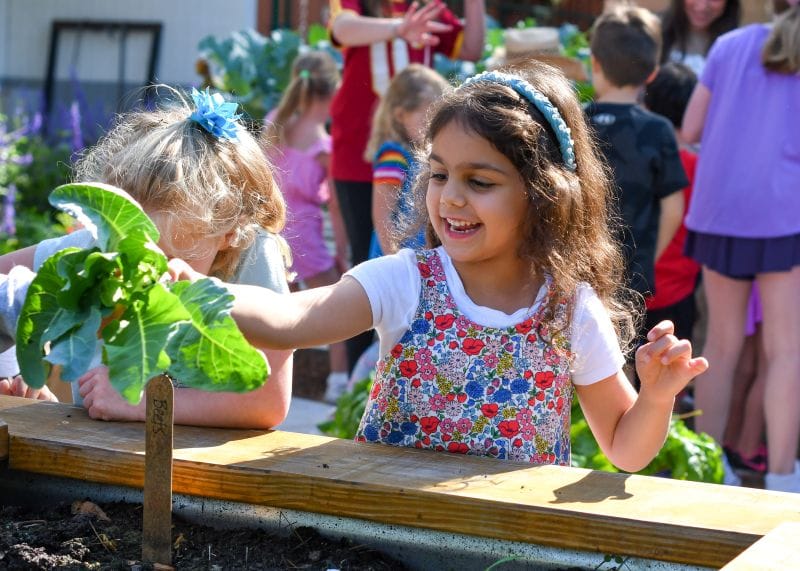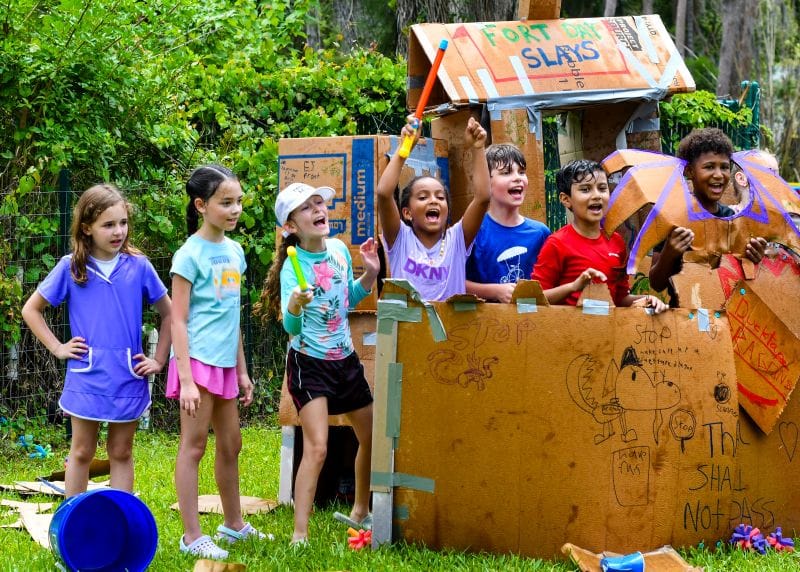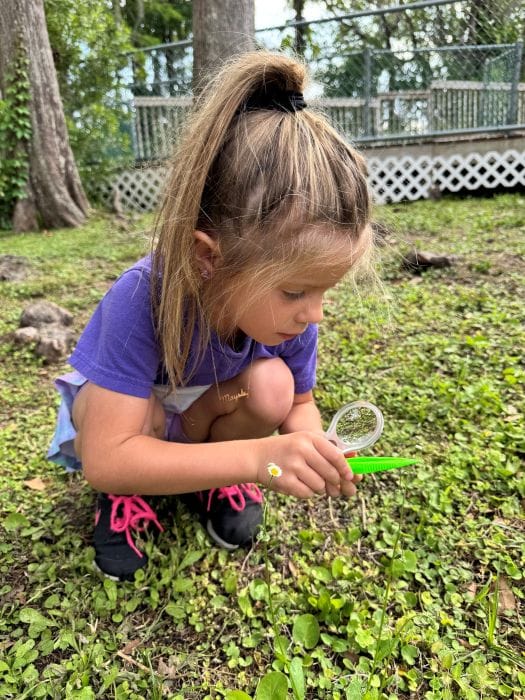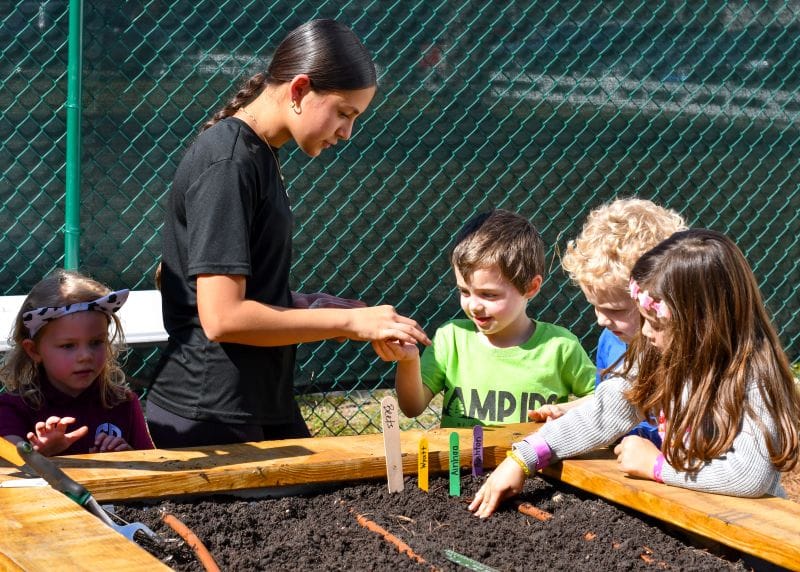The Science Behind Why Nature Is the Best Classroom
Children love to be outside. Whether they are jumping in puddles or building forts, spending time outdoors brings kids joy, laughter and a sense of freedom. But what if those joyful moments were also powerful educational experiences?
As a STEM specialist and early childhood teacher, I’ve seen firsthand the endless outdoor learning opportunities that support children’s development across all domains. At Corbett Prep, we intentionally use our outdoor spaces to enhance learning, build connections with nature and nurture our students' cognitive, emotional and physical wellbeing.
What Is Outdoor Education?
Outdoor education is the purposeful use of natural elements and outdoor environments for learning experiences. It can take many forms — structured lessons, nature walks, free play in a yard or informal learning during family hikes. Corbett Prep’s boardwalks, beautiful tree canopy and lakeside location make it easy for teachers to weave outdoor education into weekly routines. Preschoolers might explore shadows on the sidewalk to learn about light and form, while first and second graders assess the natural resources used by Native Americans.
Whether it's a messy science experiment on the grass or quiet reading time beneath a tree, outdoor education integrates all of the senses and allows students to connect with the world in meaningful ways.
The Outdoor Classroom
Traditionally, learning is associated with desks, worksheets, whiteboards and a classroom with four walls. Time spent outside is viewed as a break from “real work.” But this mindset overlooks a fundamental fact: Learning and play are deeply interconnected, and both thrive in natural spaces. Yet, children’s time outdoors is in decline, replaced by screens, schedules and safety concerns. By reclaiming our time outdoors, we give kids the space they need to play, learn and flourish.

Nature and the Brain
Attention and Memory: Natural environments stimulate the brain without overwhelming it. Even short walks in green spaces can significantly improve attention spans and working memory. For children who struggle to pay attention, time in nature can calm and focus the mind. And, as outdoor education advocate Erin Kenny put it, “You can’t bounce off the walls if there aren’t any walls.”
Math and Science: Nature offers hands-on opportunities to apply STEM concepts. At Corbett Prep, this may look like an outdoor scavenger hunt for three-dimensional shapes, a vegetable harvest from the school garden or a canoe trip to collect water samples for the Lakewatch monitoring program. Outdoor STEM activities build inquiry and experimentation — core components of scientific thinking.
Language and Literature: Children develop a stronger vocabulary and retain information more effectively when they can connect new words and ideas to real experiences. Being immersed in a dynamic, living environment enhances empathy, perspective-taking, observation and the ability to make inferences — essential skills that support language development.
Additionally, many exceptional children’s books build a meaningful bridge between literature and real life. STEAM specialists in Corbett Prep’s Tomlin Family Application Lab often use books to set the stage for our biological and ecological investigations.
Creativity and Critical Thinking: Nature is unpredictable, open-ended, and rich with materials for play and learning. A humble pile of sticks can become a fort, balance beam, lever or musical instrument. These moments of play nurture problem-solving skills, risk assessment and creativity in ways that indoor environments often can’t. Nature also supports “self-scaffolding,” where students can choose and modify challenges to match their comfort and abilities.

Social and Emotional Growth in the Great Outdoors
Time in nature helps children regulate their moods, reduce anxiety and manage stress. Engaging in age-appropriate risk-taking, such as climbing a tree or jumping over a stream, builds resilience and boosts self-confidence. The unstructured nature of outdoor play also fosters collaboration, communication and conflict resolution as kids learn for themselves how to negotiate roles, solve disagreements and take on leadership responsibilities.

Physical Movement and More
Outdoor environments invite children to run, jump, climb and balance. These activities support gross-motor development, coordination and cardiovascular health. The benefits go beyond fitness. Studies suggest that regular exposure to nature boosts the immune system and may even help protect children’s vision.
Natural light and physical activity also help regulate circadian rhythms, leading to better sleep patterns — something every parent can appreciate.

How to Get Started: Bringing Learning Outdoors Home
You don’t need acres of forest or an ecology degree to bring the benefits of outdoor learning to your kids. Here are a few simple and fun ideas:
- Math and Measurement Walks: Bring a tape measure, ruler or yardstick on your next walk. Estimate and compare the height of a mailbox, the width of a sidewalk crack or the circumference of a tree trunk. Who has the best estimation skills?
- Start a Collection: Use an egg carton or shoe box to collect seeds, shells, stones, leaves or even soil samples. Collecting inspires observation, diligence, sorting and comparison. Encourage labeling, counting and displaying their collection.
- Bring the Outside In: Incorporate natural materials into your inside routines. Use stones as math counters, turn shells into craft supplies or cut flowers to dry or dissect.
- Paint with Water: Grab a container of water and an old paintbrush (or a few!) and “paint” the sidewalk, fence posts, trees, rocks … anything! Watch how water affects textures, highlights wood grain, deepens colors and gradually evaporates. This is a great option for mixing up spelling practice, letter formation, practicing hand-eye coordination and more while encouraging observation and creativity.
- Dress for Success: Embrace the saying, “No bad weather, only bad clothing.” Rain boots, jackets, hats, and sunscreen make it possible to enjoy the outdoors in all seasons. Inclement days often make the best memories!
- Be the Model: Your attitude about bugs, weather and getting messy sets the tone. If you’re willing to get a little muddy, inspect a spider or marvel at a cloud, your child is likely to follow your lead.
Outdoor education doesn’t require perfection — just presence, patience and a spirit of curiosity. The outdoors is more than a beautiful backdrop at Corbett Prep — it’s a vital, living classroom. And with a little creativity, every parent can unlock the benefits of outdoor learning for their children.
*Presented by Corbett Prep | Originally published in the August 2025 issue of Tampa Bay Parenting Magazine.


